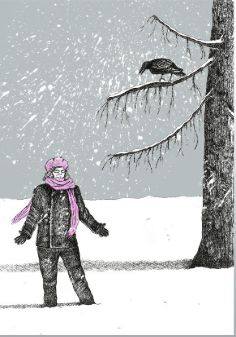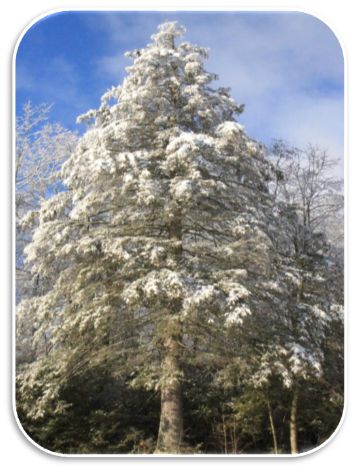- Books Name
- Online English tutor English Book
- Publication
- Online English tutor
- Course
- CBSE Class 10
- Subject
- English
Dust of Snow
By Robert Frost
Introduction
The poem “Dust of Snow” by Robert Frost illustrates a deeper sense. It explains how little and unimportant things can make our day happy.
Robert Frost (1874–1963) was an American poet who depicted realistic New England life through language and situations familiar to the common man. He won four Pulitzer Prizes for his work and spoke at John F. Kennedy's 1961 inauguration. Famous works include “Fire and Ice,” “Mending Wall,” “Birches,” “Out Out,” “Nothing Gold Can Stay” and “Home Burial.” His 1916 poem, "The Road Not Taken,"
Theme
In the poem "The Dust of Snow" Robert Frost talks about the importance of small things in our lives. These unexpected things happen in life and they bring their own effects and impacts. Even things of bad omen can be the reasons behind causing good things in your life. The poem shows the healing nature of the nature. The poet goes against the established traditional followings and sayings by depicting the symbols of bad omen crow and the hemlock tree as the reasons behind bringing a change of mood of the poet from gloom and hopelessness to optimism
Explanation

The way a crow
Shook down on me
The dust of snow
From a hemlock tree
Word meanings
Shook- shake
Hemlock- a poisonous tree with small white flowers

The poem sets in woods where the poet walking by a tree is in a bad mood and is walking by a tree, a hemlock tree, a poisonous one considered bad for luck . Suddenly a crow shooked as a result a dust of snow fell upon him.
Has given my heart
A change of mood
And saved some part
Of a day I had rued.
Rued- held in regret
The author was not in a good mood but the falling of the snow on his head lifted his mood instantly. Thus, rest of it was saved by the crow and the hemlock tree.
Generally, hemlock tree and crow are considered a carrier of bad luck but in this poem they are used as a mean of happiness and joy. The poet has portrayed the power of nature which can make anyone free from tension with its little and simple things.
Dust of Snow Literary Devices
- Rhyme Scheme- abab cdcd
- Alliteration- the occurrence of the same letter or sound at the beginning of adjacent or closely connected words.
The instances of alliteration are as follows-
- Has given my heart
- And saved some part
- inversion – when the structure of a sentence is changed by the poet to create rhyme, this poetic license is called inversion. In stanza 1, inversion can be seen.
- assonance – the prominence of a vowel sound throughout a line is called assonance. In stanza 1, line 2 – “Shook down on me” – ‘o’ sound is prominent.
- enjambment – when the same sentence continues to the next line without the use of any punctuation marks, it is called enjambment. It has been used throughout the poem.
Dust of Snow Summary
The short poem by Robert Frost depicts the incredible healing power of nature through its tiny things.
It’s beauty of the smallest thing that provide instant energy and can soothe our mind to get free from sorrow and grief.
The poem starts with poet saying that he had a bad experience since morning .
While he was passing through woods,
He happened to cross the path by hemlock tree ( considered as a carrier of bad luck) when suddenly due to the movement of the crow snow dust from the tree fell upon him.
The beauty of snow dust gave him instant joy that he forgot all his worries and sorrows.
In this way the rest part of his day got saved from getting sad .
Thus, he realised the power of nature and how petty his problem was.
The fact that hemlock tree is poisonous combined with crow being the indicator of doom and fear are used in the poem as the carriers of happiness in the life of narrator is ironical.
Through this poem the poet has also tried to depicts that the creature which are considered
Carriers of doom can bring joy.
It is just prejudice through which we
Believe something bad and relate them with bad luck.
Dust of Snow Question Answers
Q1. What is a “dust of snow”? What does the poet say has changed his mood? How has the poet’s mood changed?
Answer. The tiny particles of snow that resembles as dust together is called dust of snow.
The poet was in gloomy mood since the very beginning of the day. In his sorrow and dismay he was passing by the hemlock trees in woods, where suddenly due to the movement of the crow the dust fell on him and he got delighted with the beauty of snow dust.
In this way his mood got changed.
Q 2. How does Frost present nature in this poem? The following questions may help you to think of an answer.
(i) What are the birds that are usually named in poems? Do you think a crow is often mentioned in poems? What images come to your mind when you think of a crow?
Answer. Birds like sparrow, nightingale and peacock are more than often named in poems. Unlike these birds, crows are often seen as the indicators of doom and fear. They are often used for negative references.
(ii) Again, what is “a hemlock tree”? Why doesn’t the poet write about a more ‘beautiful’ tree such as a maple, or an oak, or a pine?
Answer. The poet has used hemlock tree to illustrate that those entities which are used for negative references and Believed to be a carrier of bad luck may also bring out joy in life.
Hemlock is considered as a source of badluck as it is poisonous. However, in the it has become the mean of joy for poet.
(iii) What do the ‘crow’ and ‘hemlock’ represent — joy or sorrow? What does the dust of snow that the crow shakes off a hemlock tree stand for?
Answer. Crow and the hemlock tree represent sorrow. However, they both have changed the mood of poet from sorrow to joy. Through this poem, the poet wants to change the preconceived notions about some typical things, that are just based upon thoughts.
The dust of snow stands for joy

 ACERISE INDIA
ACERISE INDIA
 Online English tutor
Online English tutor
